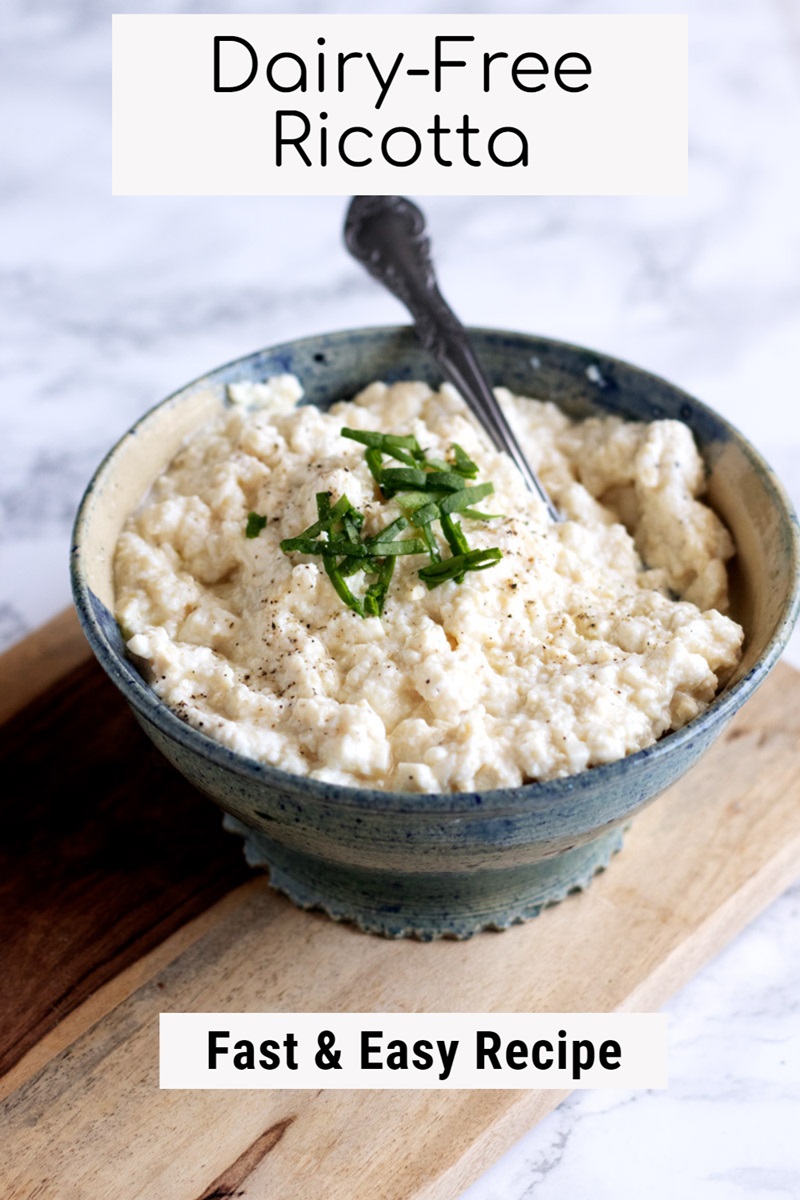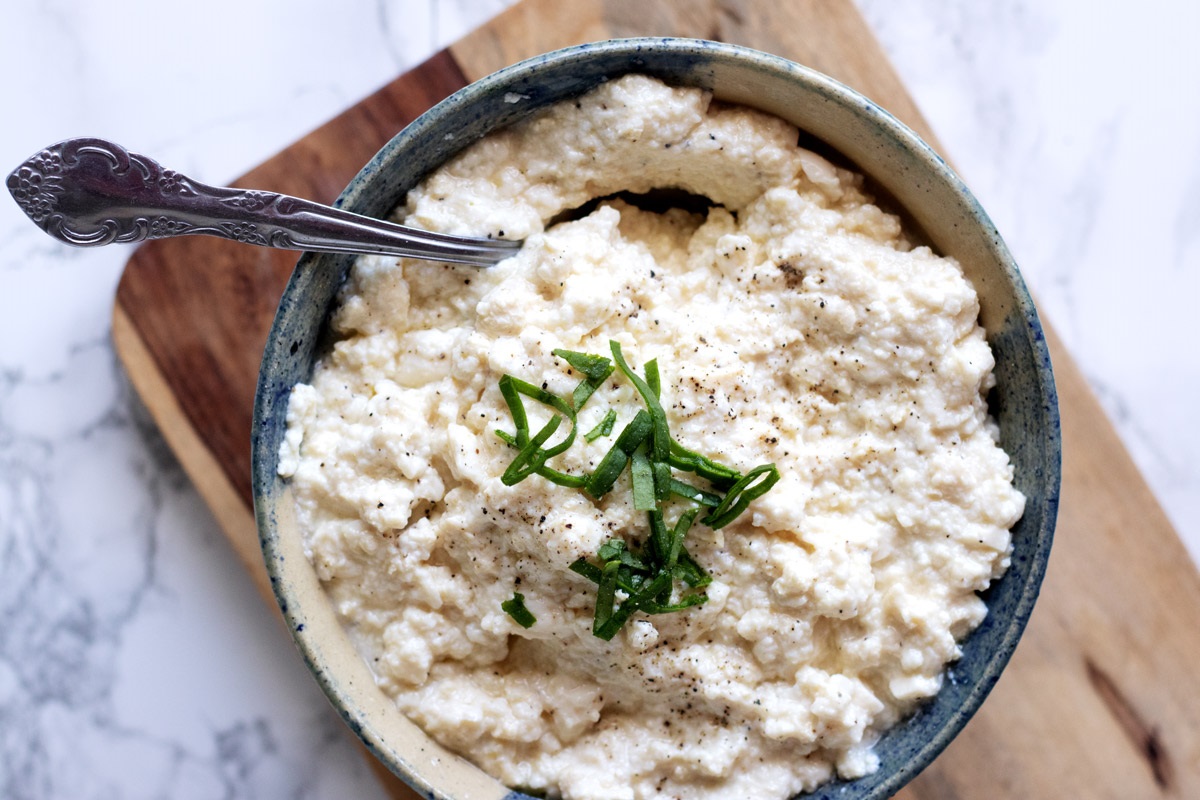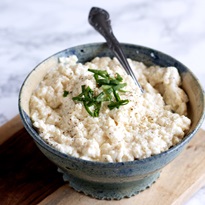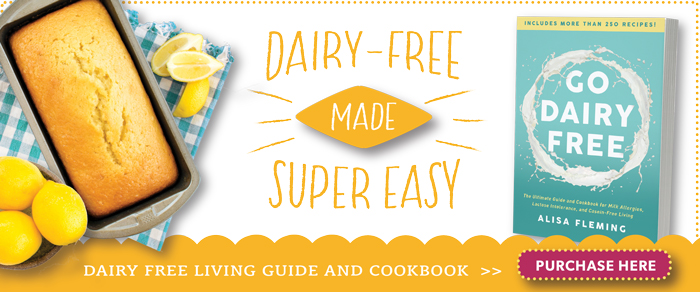I’ve whipped up many types of dairy-free ricotta cheese alternatives over the years, but frequently return to this fat, easy, and delicious tofu ricotta. It’s actually lower in fat, calories, and carbs than dairy ricotta. Yet, it’s higher in protein! In terms of baseline nutrition, it’s a powerhouse. And in terms of taste and texture, it’s positively wonderful. I’ve used it in so many recipes!

Keep it Simple with this Dairy-Free Ricotta Cheese Substitute
With the help of my recipe crystal ball, I’ve been able to predict questions that some of you might have about this dairy-free ricotta cheese alternative. And I have answers!
Does this Dairy-Free Ricotta Cheese work in Lasagna?
Yes, it’s fabulous in dairy-free lasagna! It’s also great in stuffed shells, ravioli, and tortellini. It can also be used in dairy-free crepes, spread on toast, or stirred into pasta or casseroles. If using in a sweet recipe, I would personally omit the nutritional yeast. But that’s just my personal taste.
Is the Batch Equivalent to a Tub of Ricotta?
A 15-ounce tub of dairy ricotta cheese contains about 1 3/4 cups. This recipe makes about 21 ounces, or 2 1/2 cups. Just use 1 3/4 cups if your recipe calls for one 15-ounce container of ricotta. If your recipe calls for a large 32-ounce tub of ricotta, you’ll need 1 1/2 batches of this recipe.
Why Do You Use Two Types of Tofu? What’s the Difference?
Silken tofu is generally softer and creamier than “regular” tofu, which holds it’s shape better. The silken tofu provides the creamy base, while the regular firm tofu helps give that ricotta-like texture. Regular firm tofu is sold refrigerated, but silken tofu can be sold shelf-stable or refrigerated. I use mori-nu silken tofu, but buy whatever regular tofu is on sale. The regular tofu often comes in 14- or 16-ounce blocks. In either case, you’ll use about half the package. You can use the remaining tofu to make half a batch of Thai Vegetable Hot Pot or a quick Vegan Lasagna Soup. Here is a great guide to the different types of tofu.
What Type of Oil Do You Use?
I use olive oil or grapeseed oil. But any neutral tasting oil that you use for cooking should work well. I think avocado oil would also be tasty. But I would avoid coconut oil for this particular recipe. You are mixing with cold tofu, which can cause the coconut oil to solidify into little beads when added, causing a strange consistency. It will also cause the dairy-free ricotta to set up more firmly.
Can I Omit the Nutritional Yeast?
If you have it, or can buy it, I recommend using it. But if you avoid yeast of all types, or simply don’t have any and need to make this right now, it will still be tasty without it. Nutritional yeast is just a seasoning, and it adds that little bit of cheesy umami.
Is their a Substitute for Nutritional Yeast?
I haven’t tested the ratios, but I find that light or white miso offers a similar umami that’s just a little less cheesy, but more fermented in taste. I use miso in my Dairy-Free Cottage Cheese Recipe, which is also delicious in lasagna! For this dairy-free ricotta, I might start with 1 teaspoon of miso in place of the nutritional yeast, and reduce the salt to 1 1/4 teaspoons. You can find miso in the Asian section of many supermarkets, or in the refrigerated section near the produce. Most grocery stores carry it, but some brands are shelf-stable while others are sold refrigerated.
Can I Make this Dairy-Free Ricotta Oil-Free?
Technically, yes, but that will take away some of the richness. And you might need to reduce the seasonings a little. They won’t carry as well without the touch of fat.
Do You Have a Soy-Free Dairy-Free Ricotta Option?
I have two! In Go Dairy Free: The Guide and Cookbook, I have Almond Ricotta and Cashew Ricotta recipes. But if you can eat soy, don’t shy away from the tofu ricotta recipe. It really is delicious and full of nutrition! If you’re simply concerned about soy and health, choose tofu that is made with whole soy and doesn’t contain soy protein concentrate or isolate. Very high amounts of soy protein concentrate or isolate, not whole soy, are the types called out in most studies.

Special Diet Notes: Dairy-Free Ricotta
By ingredients, this recipe is dairy-free / non-dairy, egg-free, gluten-free, grain-free, nut-free, peanut-free, added sugar-free, vegan, plant-based, vegetarian, and keto-friendly.
- 1 (12-ounce) package firm silken tofu
- 8 ounces firm tofu
- 2 tablespoons oil
- 1 to 2 tablespoons nutritional yeast flakes, to taste
- 4 teaspoons lemon juice
- 1½ teaspoons salt, or to taste
- ¼ teaspoon black pepper
- 1 teaspoon dried or 1 tablespoon fresh oregano, basil, thyme, or parsley (optional)
- Drain and gently press the tofus, using a tea towel or paper towels, to remove any excess water.
- Put the pressed tofus, oil, nutritional yeast, lemon juice, salt, and black pepper in a medium bowl. Mash with a fork or potato masher until all ingredients are well incorporated and the mixture takes on a ricotta-like texture, about 3 minutes.
- Stir in the herbs (if using).
- Store in an airtight container in the refrigerator for up to 3 days.



8 Comments
Is there an alternative to the nutritional yeast? I see that it can be omitted but was wondering if there was a yeast free alternative?
Hi Kelly, there isn’t an even substitute for nutritional yeast. As recommended in this recipe, I would omit it. If you want a touch of umami, you can add a little miso, to taste.
Pingback: 10 SURPRISING POSITIVE SIDE EFFECTS OF FOOD ALLERGIES - ALLERGIC PRINCESS - Food Allergies
Just curious what is the purpose for the nutritional yeast? Can it be left out if I can’t find it?
Hi Kimberly, nutritional yeast gives it that cheesy “umami” flavor. You can omit it, for a little less cheesiness, but still good alternative. I’ve made tofu ricotta quite a bit without nutritional yeast. I do recommend trialing nutritional yeast some time though. One package goes a long ways as you only need a little and it’s very light.
Good recipe. If you use it in a dish, like lasagna, I would omit the spices. But, I do love nutrition yeast!
Glad you enjoyed it, and thank you for the feedback Debbie!
Pingback: Red Pepper and Artichoke Strudel | justinececile